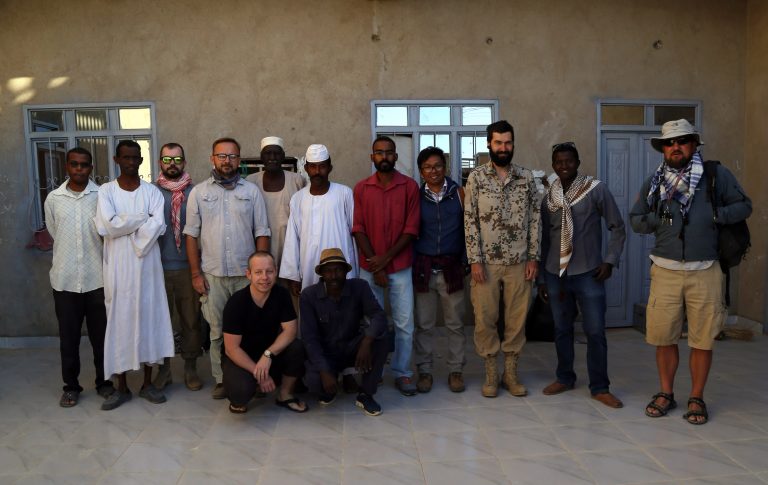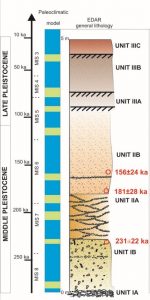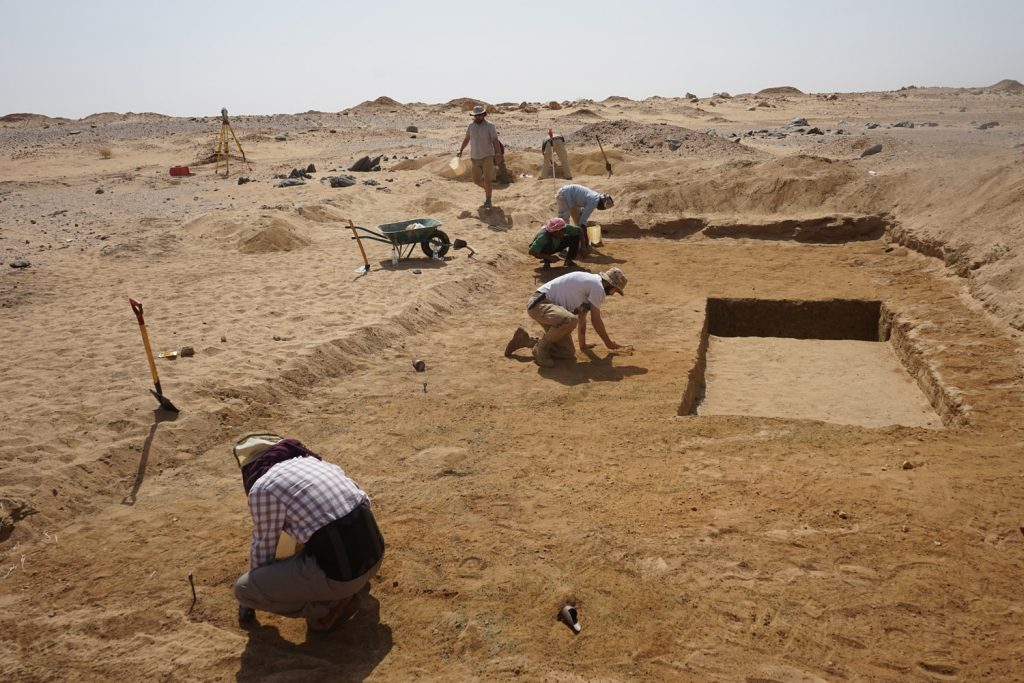Season 3
Works done by the Expedition in 2019 were basing on the license, dated 29.01.2019, given by the Director General of National Corporation for Antiquities & Museums (NCAM) – Dr. Abdelrahman Ali Mohamed to Dr. Mirosław Masojć, University of Wrocław, Poland as well as to Al Neelian University.
The third season of the project was devoted to completion of the field works and elaboration of materials gathered so far.
Field work was conducted on the following sites:
Site EDAR 7 –
The oldest archaeological site in Sudan
This site, well dated by OSL, has been surveyed again this season. The fluvial level bearing Acheulean artifacts was explored at one of the walls. Singular hand-axes have been found and while doing that a space between the walls was checked for the possibility of a presence of an undisturbed Acheulean horizon. This was cleared and documented. Fluvial sediment has been preserved there. At the top of it Acheulean artifacts were visible.
The area was excavated. Artifacts were discovered and measured at spot with additional sieving of the sediments. A number of small artifacts came from the sieving.
The inventory from EDAR 7 contains typical structure for the Acheulean site: chopping tools, hand-axes, debitage from the production of hand-axes, tools (perforators, denticulates, end-scrapers, side-scrapers, retouched flakes, cores for flakes, giant cores exceeding 15 cm length, debitage, waste). Raw materials used for the production of the industry was made mainly of quartzite. Only few artifacts are being made of rhyolite, chert, Hudi chert or quarzitic sandstone.
This is so far the oldest and the best stratigraphically set Acheulean collection in Sudan. It is dated by the OSL.
Site EDAR 135
The works ware continuing at the site. The dated horizons from the last season ware excavated this year. To obtain that an overlying sediment of a thickness of ca. 2-2,5 m has to be removed. First work were concentrating on the earth removal which was done manually.
There were two horizons to be excavated. Both belong to the sedimentological Unit II of the area. This is the fluvial horizon with two occupational episodes present: younger, located between OSL dates 3 and 4, and the second, located between OSL dates 1 and 2.
Lower horizon between OSL dates 1/2.
The second horizon underlying upper cultural layer was about 1,5 m below its bottom. The sediment between two horizons was removed manually. Few artifacts have been found while the sediment removal belonging to MSA tradition. From this horizon in a previous season a few artifacts have been found within the profile – two hand-axes and a chopper together with few flakes.
From the excavated area artifacts have been measured with addition of sieved materials, mainly chips.
Upper horizon between OSL dates 3/4.
The upper horizon – MSA – was excavated first. The inventory is made mainly on a quartzite. Few artifacts are made on rhyolites. The inventory contains Levallois cores of Nubian tradition as well as discoidal cores. From this small area a collection exceeding one thousand artifacts was excavated. Typical inventory for MSA was obtained including denticulate tools, perforators, scrapers and besides Levallois also a small multi-platform cores for flakes.
Site EDAR 144
New discovered site near EDAR 133, close to the road in the main mine.
The artifacts are visible within the walls. There are two horizons with singular artifacts referring to the site EDAR 135 – upper fluvial layer referring to UNIT II from EDAR 135 (between OSL dates 3/4) and to UNIT II from EDAR 135 (between OSL dates 1/2). The latter one is a hand-axe and a fragment of a flake. First one is a big cortical flake.
Site EDAR 155
The works from 2018 were continued. The 2018 trench was extended. The recent cover has been removed. Further MSA materials excavated. This site is located outside the reach of the goldmines therefore it is not heavily destroyed. Only top parts of the sediments has been removed by surficial gold investigations. A plan of the site has been made.
The site, well dated by OSL, contains Levallois stone materials made on quartzite and rhyolite. Cores, tools and debitage measured have been collected.
Conclusions
EDAR area, after three field seasons, appears as one of the most important early prehistoric areas in Sudan. It contains several very significant archaeological episode, which are as follows:
- The oldest, so far, hominins (homo erectus) settlement in Sudan and NE Africa
- The youngest hominins settlement in Sudan and Africa of the Acheulean tradition dated to time span 180-230 ka;
- One of the oldest homo sapiens MSA settlement remains
Those hominins settlement episodes, found deep in the desert far away from the present Nile, are the manifestation of a green corridors existing in the Middle Pleistocene in the area of a present Eastern Desert.
The activity of the gold miners in the Eastern Desert made possible the discovery of an important region with numerous Acheulean and MSA sites. The number of sites in the EDAR area, which is a small patch of desert disturbed by gold diggers (ca. 3–4 km2), suggests a potentially much larger number of sites that record hominin activity during Pleistocene wet periods in the desert, now covered by thick sediments. The environment of the EDAR sites in the Eastern Desert is characterized by an ephemeral braided stream that was suitable for human occupation during the Middle Pleistocene until the climatic deterioration under the sustaining drought events in the Sahara. Responding to Quaternary climatic changes, hominin dispersal of the Acheulean tradition and early MSA was channeled through vegetated corridors of the Atbara river basin during the pluvial or interglacial periods since the Middle Pleistocene.







